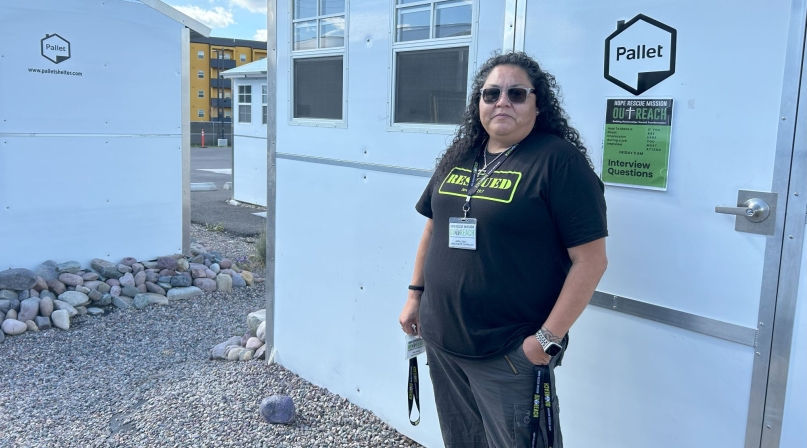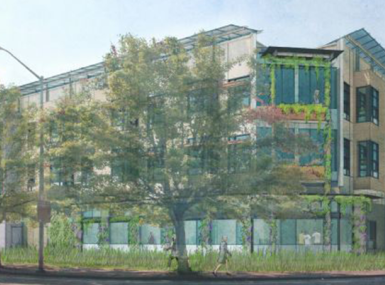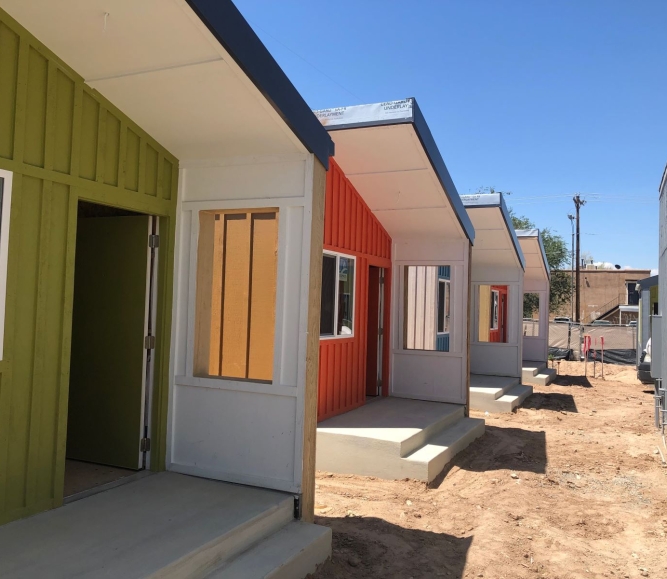Missoula County puts unhoused residents on solid ground

Key Takeaways
Missoula County’s first Temporary Safe Outdoor Space was appropriately “Montanan.”
Atop 40 wooden platforms, mountaineering tents gave unhoused people a place to consider their home base after the state Department of Transportation barred them from camping under a bridge. The tents boasted a bucolic view of Blue Mountain and the sound of the nearby Bitterroot River. The county’s CARES Act money covered the supplies.
But the tents weren’t ideal for all-weather conditions over the long term. Plus the land — rented cheap from a private landowner — was in a flood plain. The offices for caseworkers, in a yurt, were heated by propane.
So, the partnership between Missoula County, faith-based Hope Rescue Mission and the United Way moved the Temporary Safe Outdoor Space (TSOS) to paved, county-owned land in early 2023, much closer to supportive services and most importantly, inside durable 100-square foot fiberglass-reinforced plastic shelters.
Also added: An actual pair of shower trailers and an office for Hope staff who are on site 24 hours a day. The county has funded the program from its American Rescue Plan allocation and the city of Missoula contributes financially, too.
“We know we’re not going to solve homelessness, but we can help a few dozen people move ahead with getting their lives on track,” said Commissioner Juanita Vero. “This wouldn’t work with 200 people. It works with 40 people. This works because of the scale.”
April Seat, Hope’s outreach director, had been working in the field for four years prior to the pandemic, so she had a lot of credibility with the community, who understood what she was looking for.
“We invited them into the process, I took them to the site, they saw it as we built it,” she said. “They thought we were going to build a FEMA camp [of soft tents] so they were glad to see we weren’t doing that.”
It was hard at first, she said, because of strict rules against bringing drugs, alcohol or guests into the village, and limits on how much people could store in their shelters — to prevent hoarding — but Seat said the ease with which residents were connected with human services, thanks to their fixed address, fueled more enthusiasm and uptake.
The standards for conduct are much higher than at the camp site, which means the TSOS is not always filled to capacity, but the residents want to be there and live by the rules.
“We realized when we brought people in that they might never want to leave,” Seat said. “That’s why we always want them working toward their next step, preferably 30-, 60- and 90-day-plans. We can usually see in 30 days if they’re going to be a good fit or not (TSOS staff work with other service providers to find the best for residents who don’t work out). Then we should be looking for employment within 60 days and housing within 90 days.”
It’s not a hard-and-fast rule, though. Dustin Grace lived in the TSOS for a year while collecting himself after 13 years of living on couches and in his car in Cascade County, where he moved hoping to run from his painkiller addiction that developed in his hometown in Maine.
“I thought I’d never get in,” he said. “I was number 82 on the list, but I stayed by my phone and eventually, enough people didn’t pick up and they called me.
“As soon as I was in, I felt my life get better. It wasn’t much of a home, but I had my own place to stay. I felt safe at night.”
Seat interjected: “But Dustin did the work, that’s what makes it successful — submitting to what it is they need to do to get the help they need.
“It’s important we address the trauma that led to their situations. Instead of ‘What’s the matter with you?’ we ask, ‘What happened to you?’ And then we work on that.”
“Over the three years we’ve been doing this, what’s worked the best has been the accountability, the compassion and really jumping into their world and trying to figure out ‘What happened to you?’ and how can we address that?” Seat said.
Grace chimed in: “But you have to want it. You have to be accountable for everything in your life, and as soon as you lay off, then you start to slide back.”
Residents stick to budgets and pay utility fees for their heat, electricity and internet access.
They have access to job search assistance services, including interview preparation.
In 2023, the TSOS program saw only one resident incarcerated and three back in shelters.
“We always stay in touch, and if they need it, we’d bring them back,” Seat said.
Grace now lives in an apartment with a friend who he met in a shelter prior to TSOS and is hoping to ply his life experience and recovery to help others in the same situation.
The county commission voted in September to allocate $740,000 of its remaining American Rescue Plan funding to help run the TSOS for 2025 and 2026 and is working to find a dedicated funding source to keep the TSOS running beyond that time.
“It’s a tiny step toward combating homelessness, but it’s a demonstration of what can be successful,” Vero said.
“It’s successful because of the partnership and the culture and the people. This isn’t something you can do top-down and expect it to work, you can’t just set up 40 pallet shelters and just hire some nonprofit to come in. It works because of the trust and results from the years of working together.”
Related News

Sonoma County creates solutions to homeless crisis
Wildfire devastation and the COVID-19 pandemic contributed to a homelessness crisis in Sonoma County, Calif., prompting the county to create more comprehensive housing offerings to better meet the needs of its most vulnerable populations.

U.S. Senate Committee approves legislation to reauthorize programs for older adults
On July 31, the U.S. Senate Committee on Health, Employment, Labor and Pensions (HELP) approved the bipartisan Older Americans Act Reauthorization Act of 2024 on a 20-1 vote.

Arizona county leads nation in identifying indigent remains
Pima County seeks to offer closure to next of kin following the death of an indigent person.
County News
N.M county builds tiny homes for its transient population

